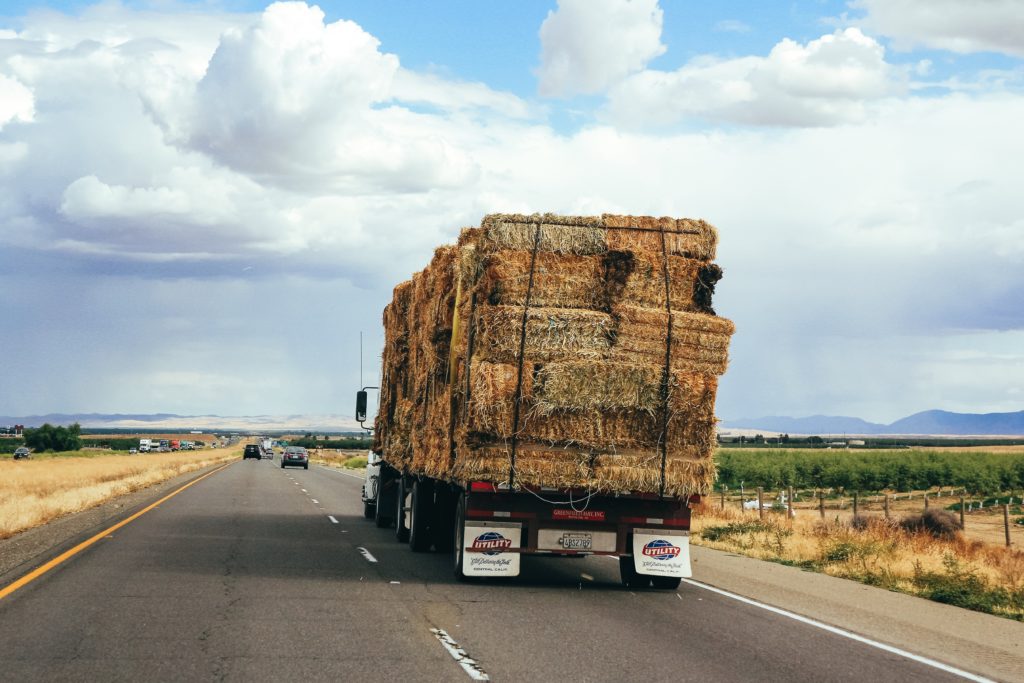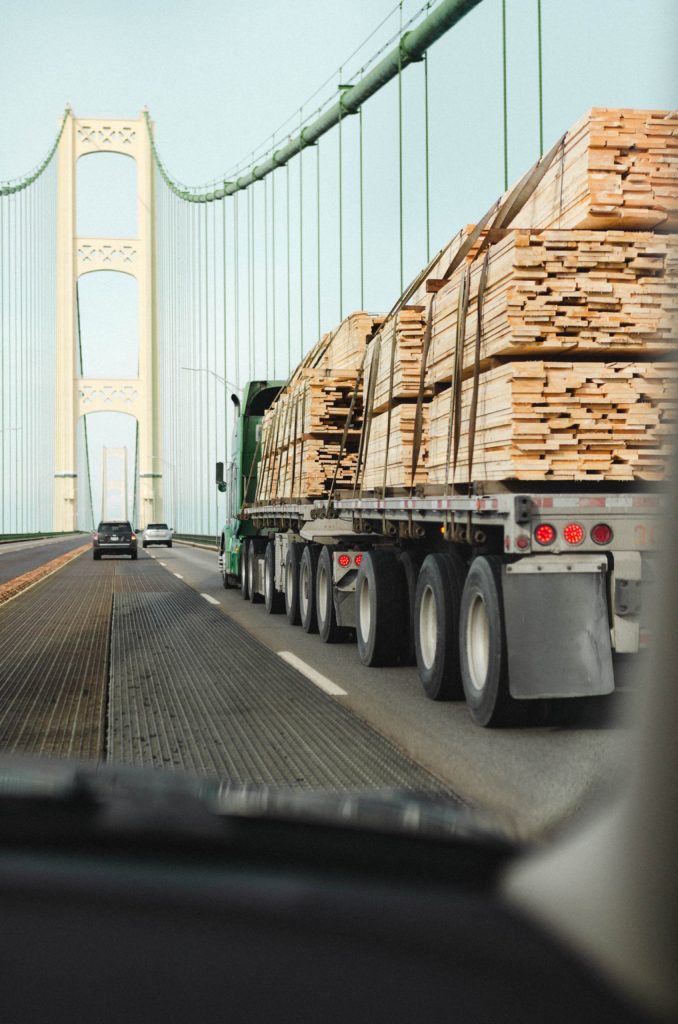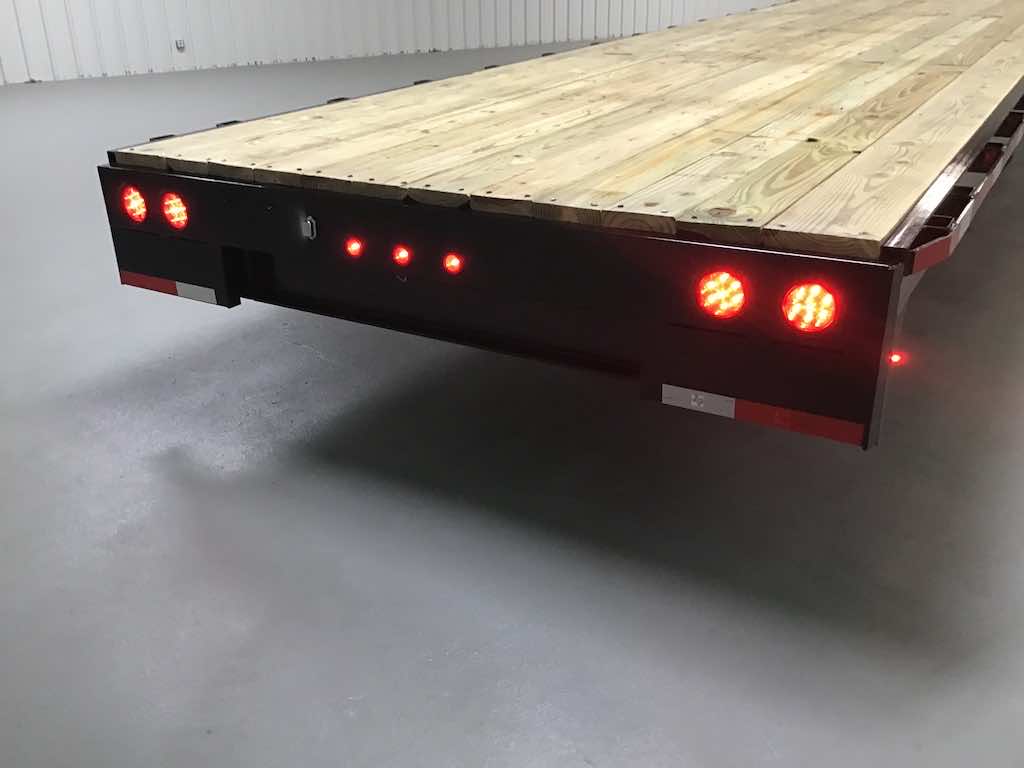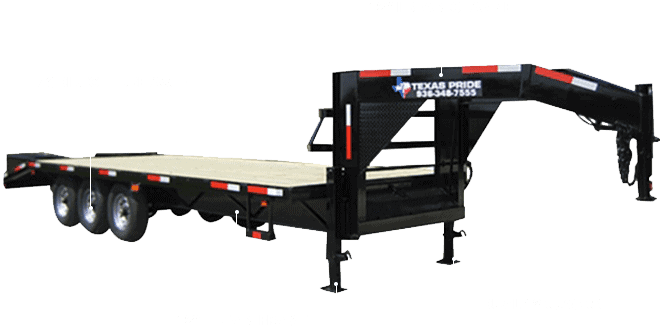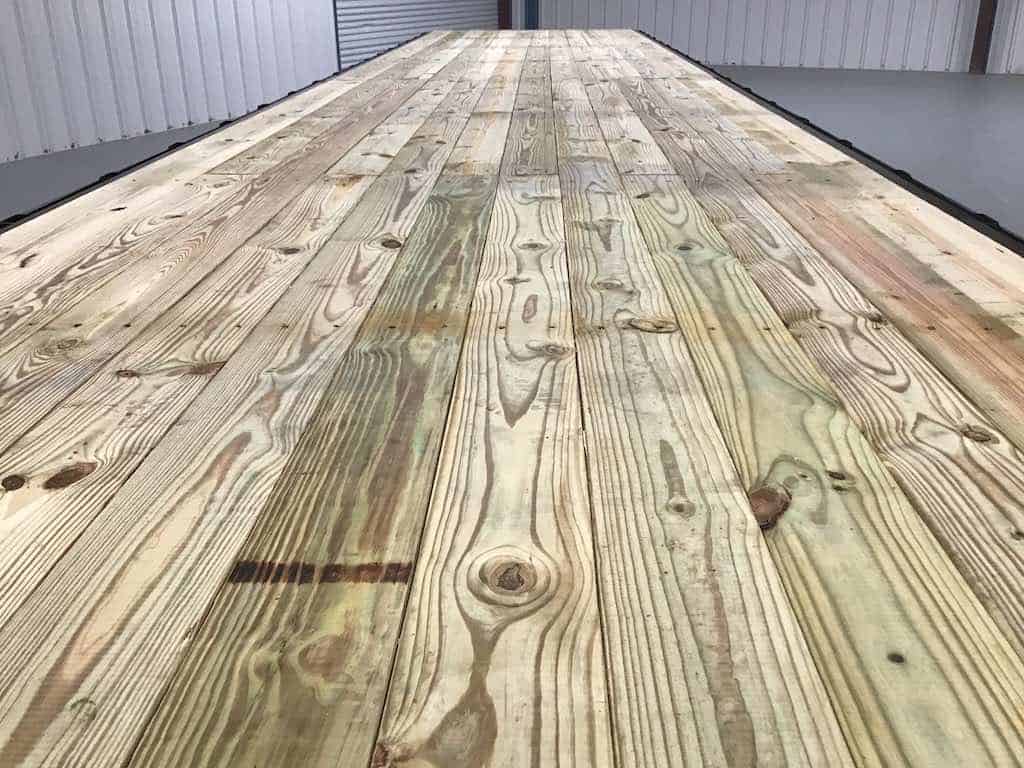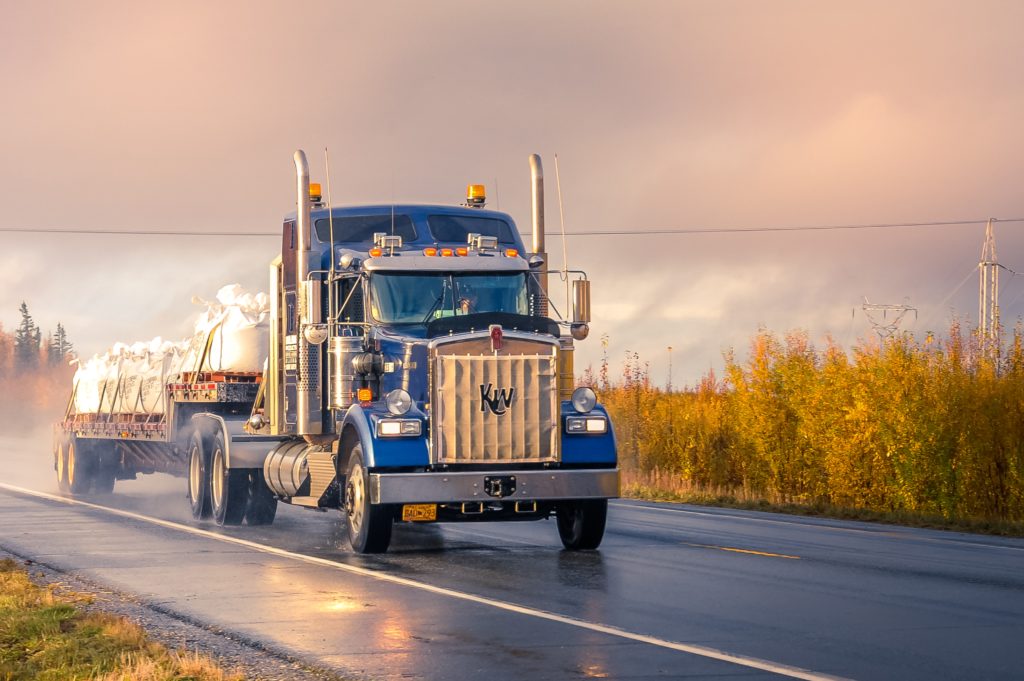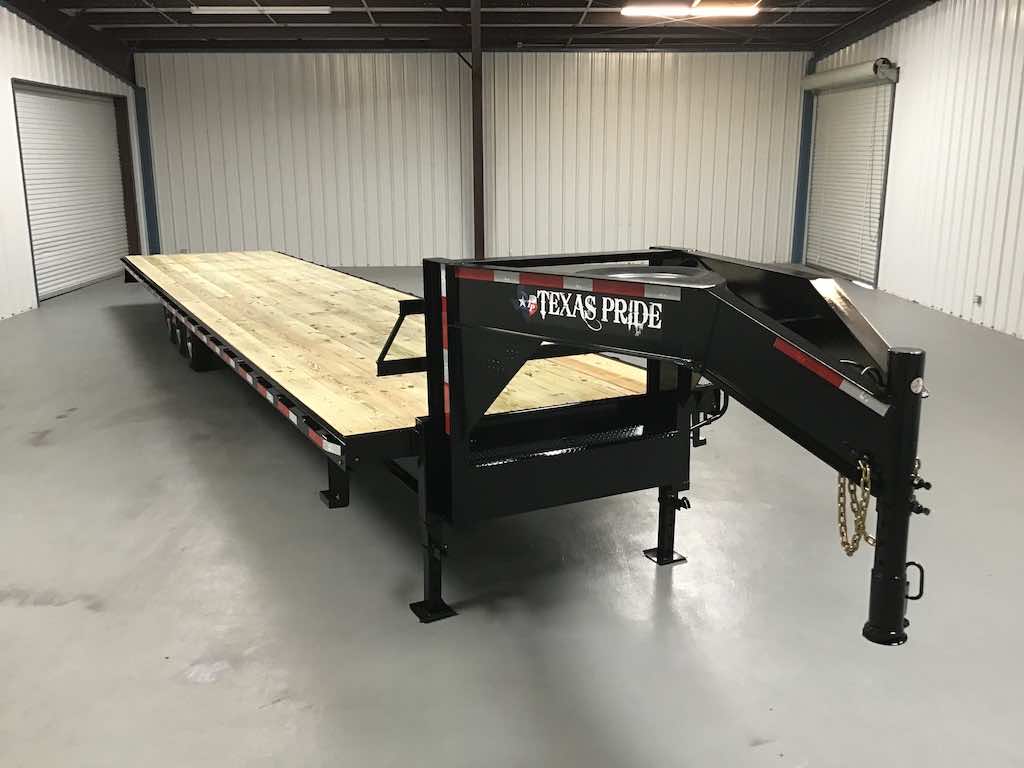
A flatbed trailer is a typical open deck equipment that has no roof nor sides. It is mainly used for transporting heavy, oversized, wide and indelicate goods such as machinery, building supplies or equipment.
The flatly shaped body makes it much easier to load and unload goods.
Due to the flatbed truck open body, the goods transported with it must not be vulnerable to rain.
With its versatility, the trailer is one of the most used. Generally, the length of the trailer ranges between 48 and 53 feet.
Flatbed Trailer Types
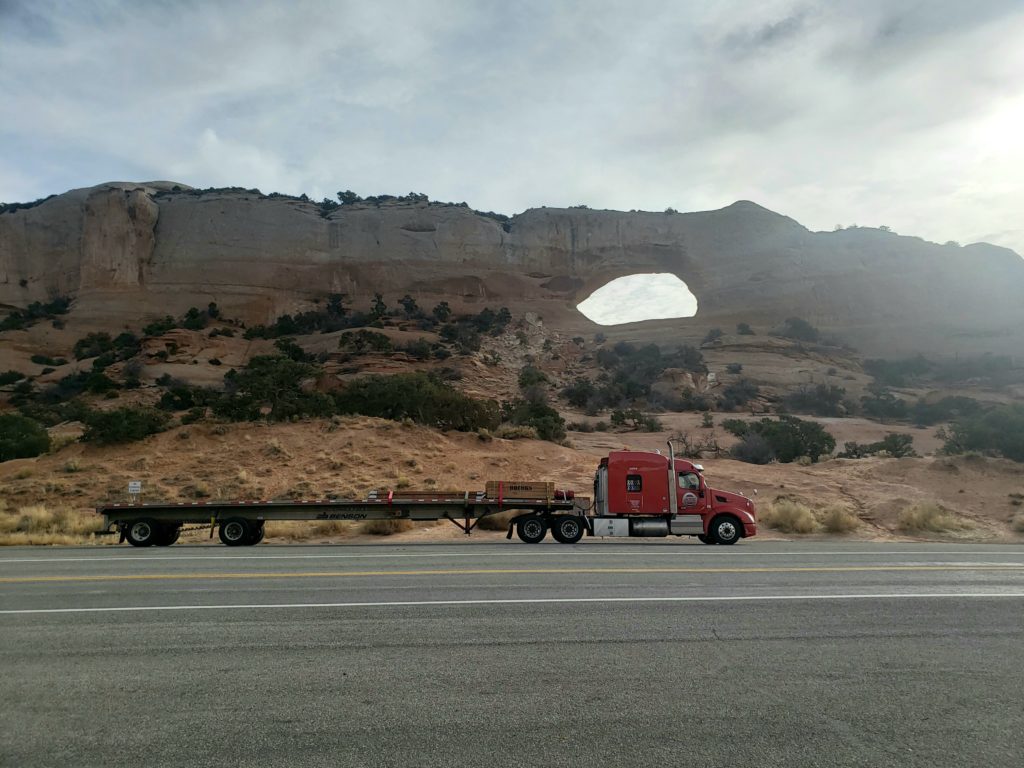
Flatbed trailers come in all shapes, sizes, and maximum load capacities. Some of the most common types of flatbed trailers and specialized trucking trailers include:
- Lowboy Trailers
- Step Deck Trailers
- Stretch Double Drop Trailers
- Removable Gooseneck Trailers (RGN)
- Conestoga Trailers
- Sidekit Trailers
Your Trailer for Hauling Construction Equipment
One major reason to use flatbed trailers is to haul equipment. In many cases, equipment used on construction sites and in roadwork, such as skid steers, bulldozers, and excavators, can be difficult to maneuver.
These items should not be driven on normal roadways. For this reason, the equipment needs to be transported from one job site to another on the back of a trailer.
A flatbed trailer makes it easy to load equipment onto the trailer, quickly relocating these bulky items to the right destination.
Beauty of Transporting Materials on a Flatbed Trailer
For large building and construction projects, bulky materials will often need to be transported to the job site. Items that might be placed on the back of a flatbed trailer include all of the following:
- Piping
- Rebar
- Lumbar
- Large concrete blocks
- Prefabbed buildings
- Steel frames
- Scaffolding
- Fence posts
- And more
The beauty of transporting materials on a flatbed trailer is that, even extremely long or bulky materials can make the cut. While an enclosed trailer requires items to fit in a specific space, a flatbed offers more room for overhang.
Best Flatbed Trailer
14,000 GVW Gooseneck Deck Over/ Flatbed
This popular flatbed deck-over trailer come with built-in ramps so you can easily drive lawn tractors off and on or move other equipment. It can be connected to most vehicles and comes in a wide variety of sizes so you can find one that fits what you need it for.
Features:
- 14,000# GVW (EXCLUDES 8522DT16)
- Tandem 7000lb Axles
- Electric Brakes
- EZY Lube Hubs
- 20″X60″ Fold Up Ramps
- 10″ I-Beam Main Frame
- 3″ C Channel Crossmembers 16″ Centers
- 8 Lug Steel Wheels
- DOT LED Lighting
- Adjustable 2 5/16 Ball Coupler
- EZY Lube Axles
- Chain Basket
- 16″ Radial Tires
- DOT Tape
- Side Step
- Stake Pockets
- Rub Rail
- Single 12,000lb Drop Leg Jack
- 7 Way RV Plug
- 102″ Wide
- Primed and Painted with Industrial Grade Paint
- Spring Suspension
- Break-Away Box
- 4ft Dove Tail Wood
- 2″ Pressure Treated Floor
- Heavy Duty Safety Chains
Flatbed Trailer Cost
New trailers typically depreciate 15%-20% when they leave the dealer’s lot and roughly 10% each additional year.
Compared with the new flatbed trailer, the price of the used flatbed container carrier trailer is definitely cheaper.
Generally speaking, a flatbed container trailer in good condition usually costs 10,000 to 20,000 USD. If it is used for a longer period of time, Maybe the price will be lower.
Load a Flatbed Trailer
- Check Weight Limits – Make sue the weight of the load is not going to exceed the weight limit or capacity for the trailer.
- Trailer Inspection – Inspect the trailer to ensure that it will be safe for the road and for the load.
- Connect the trailer to the towing vehicle – If you are loading a trailer that is not connected to a vehicle, the trailer must have rear support jacks, but this is not recommended as it is a safety risk.
- Loading Area – Move the trailer to a completely flat area. Never load a trailer on a hill or uneven ground.
- Loading – Ramps, Tilt Bed, or Side Load-If you are loading a vehicle or equipment with ramps, put the ramps in place and pull the vehicle up to the start of the ramps. Adjust the spacing of the ramps to match the alignment of the tires.
- Weight Distribution – Your load should be placed directly over the axles with a little more of the weight towards the front of the trailer. A good rule of thumb is 60% toward the front and 40% toward the back.
- Decide whether to use straps or chains. Chains should be used when securing heavy equipment and sometimes trucks. Straps would normally be used for securing light weight trucks, cars, and supplies.
- Check Your Load Frequently – Stop to check your load and ensure chains and straps are secure after the first 25 miles of driving. You are required by law to stop again every 3 hours or 150 miles for routine checks to ensure your load is secure. Look for chains or straps that have loosened or straps that have possibly rubbed and could be causing cuts or frays from rubbing.
Strap a Flatbed Trailer
To ensure that your cargo is properly secured, consider whether your items will need to be protected against the elements. Additionally, it’s important to know the weight of your items as well as what equipment you should be using.
The two most common types of securement devices are:
- Chains with binders
- Nylon straps
- After determining the weight of your items, load them into the bed of your truck. Then, you’ll need to divide the total weight of the cargo by the load capacity of an individual chain or strap.
- Inspect the position of the cargo on the trailer. Each item should line up with at least two winches on the side of the trailer. It’s best to use two straps over your items if your cargo is something that could be damaged by chains with binders. If your items won’t be damaged, use two chains with binders to secure those items. Be sure to keep the edges of all items covered with remnant carpet so the cargo isn’t damaged as you tighten the straps or chains.
- The next step is threading the hooked end of each strap down through the outer safety rail. It should then be hooked to the underframe. After rolling up the straps, throw them up and over the cargo. On the other side of the trailer, thread the strap ends through the slot in the trailer winches. Twist the winches until the slack of the strap is finally secured around the winch. After that, place the tip of the winch bar into the hole on the side of the winch and bring the bar down as often as needed to ensure that the strap is tightly secured.
- Similar to step three, you will need to thread the hooks of the chains down through the safety rail as well. Just like you threw the straps up and over the cargo, do the same for the chains. On the other side of the trailer, thread the hooks of each chain down through the safety rail and to the frame of the trailer. The slack of the chain should be allowed to dangle over the trailer’s side. You’ll then need to place a chain binder on each chain. Take one of the binder’s hooks and attach it to the highest link in the chain that’s reachable for you. Grab the other hook of the binder and pull it down. The handle of the binder goes all the way up before you take the slack in the chain and bring it up as tightly as you can. Slide the bottom hook of the binder over any of the chain links. Place the open end of the winch bar over the end of the binder handle. Lock the binder by pulling the winch bar. Make sure the chain is pulled tight.
What does a Flatbed Trailer Weigh?
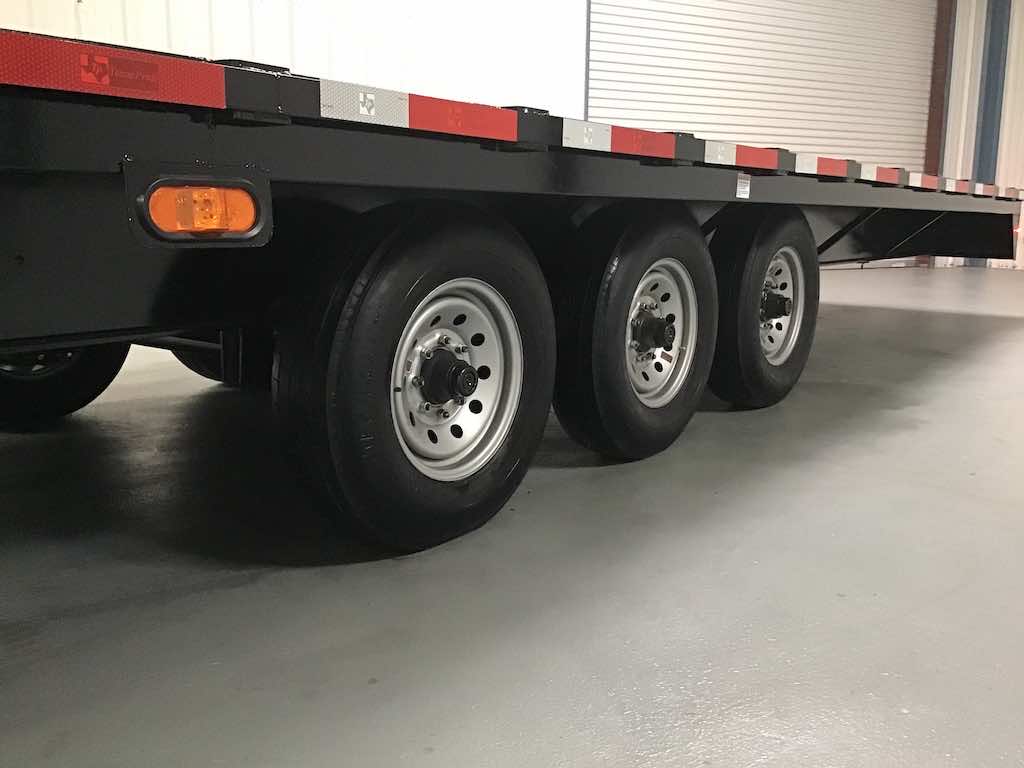
The Average weight of a flatbed trailer is about 7,000 pounds. Since most trailers of this type weigh about 100lbs per foot of deck length (16′ trailers will weigh about 1,600lbs, 18′ trailers weigh about 1,800lbs and 20′ trailers weigh about 2,000lbs), you must deduct that trailer weight off of the GVWR to find out what a trailer can truly carry on top of its own bed.
What is a Hotshot Flatbed Trailer
Many people are confused about the term hotshot or hot shot. It really means any flatbed trailer towed by a medium or heavy duty truck that delivers loads to local, regional or national locations. The tow vehicles are typically midsized-class 3, 4 or 5 trucks with four axles from RAM 3500.
Hot shot trucking is becoming an increasingly popular way for flatbed trailer owners to make a living while on the road. Hot shot truckers often drive class 3, 4, 5, or 6 rated pickup trucks (instead of full on semi-tractors), so generally it’s a more cost effective and accessible way to get into the industry.
